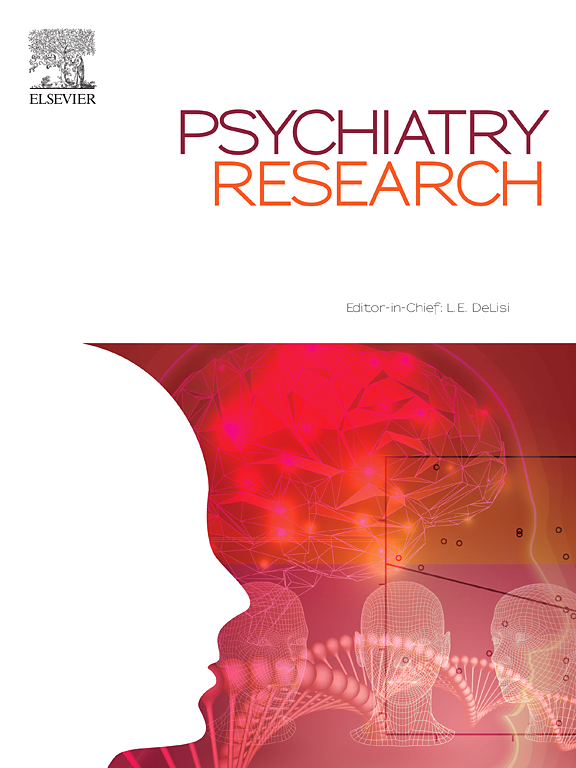Brain microstate features of patients with depression: A transcranial magnetic stimulation and electroencephalographic (TMS-EEG) study
IF 3.9
2区 医学
Q1 PSYCHIATRY
引用次数: 0
Abstract
Background
Recent studies using transcranial magnetic stimulation and electroencephalography (TMS-EEG) have revealed abnormal changes in the temporal and frequency domains associated with depression. In this cross-sectional study, we employed microstate analysis to investigate the spatio-temporal features of TMS-induced EEG signals in depressive patients. Our goal was to identify more robust and clinically relevant EEG characterizations associated with depressive states.
Methods
EEG microstate analysis was conducted on 60 patients with depression and 60 healthy controls. Depressive symptoms were assessed using the 24-item Hamilton Depression Scale (HAMD-24), while anxiety and sleep quality were evaluated with the Hamilton Anxiety Scale (HAMA) and the Pittsburgh Sleep Quality Index (PSQI), respectively. TMS-EEG data, recorded from 46 channels over a 4-minute duration, were subjected to microstate analysis using the Microstate EEGLAB toolbox 1.0. Microstate properties were compared between the groups and correlated with depressive symptoms in patients with depression.
Results
Microstate analysis identified four classes (MS1-MS4) across all participants. Depressed individuals exhibited a significant increase in both the coverage and duration of MS1 as well as the duration of MS4 (p < 0.05), while the coverage, duration, and occurrence of MS3 were notably reduced compared to healthy controls (p < 0.05). Additionally, HAMD-24 scores and factor scores were negatively correlated with MS3 parameters in patients with depression.
Conclusion
Our findings suggest that alterations in EEG microstates during TMS are closely linked to depressive symptoms, reflecting changes in large-scale brain dynamics in individuals with depression. TMS-EEG microstate analysis holds potential as a valuable tool for evaluating depressive symptoms and offers new insights into the neuro-electrophysiological mechanisms underlying depression.
抑郁症患者的脑微观状态特征:经颅磁刺激和脑电图(TMS-EEG)研究
最近的研究利用经颅磁刺激和脑电图(TMS-EEG)揭示了与抑郁症相关的时间和频率域的异常变化。在横断面研究中,我们采用微观状态分析来研究抑郁症患者经颅磁刺激诱发的脑电图信号的时空特征。我们的目标是确定与抑郁状态相关的更稳健和临床相关的脑电图特征。方法对60例抑郁症患者和60例健康对照者进行seeg微状态分析。采用24项汉密尔顿抑郁量表(HAMD-24)评估抑郁症状,分别采用汉密尔顿焦虑量表(HAMA)和匹兹堡睡眠质量指数(PSQI)评估焦虑和睡眠质量。使用microstate EEGLAB工具箱1.0对4分钟内46个通道的TMS-EEG数据进行微状态分析。比较各组之间的微观状态特性,并与抑郁症患者的抑郁症状相关。结果微观状态分析在所有参与者中确定了四个类别(MS1-MS4)。抑郁个体在MS1的覆盖范围和持续时间以及MS4的持续时间上都表现出显著的增加(p <;0.05),而与健康对照组相比,MS3的覆盖率、持续时间和发生率显著降低(p <;0.05)。抑郁症患者HAMD-24评分和因子评分与MS3参数呈负相关。结论经颅磁刺激期间脑电图微观状态的改变与抑郁症状密切相关,反映了抑郁症患者大尺度脑动力学的变化。颅磁-脑电图微状态分析有潜力成为评估抑郁症状的有价值的工具,并为抑郁症的神经电生理机制提供了新的见解。
本文章由计算机程序翻译,如有差异,请以英文原文为准。
求助全文
约1分钟内获得全文
求助全文
来源期刊

Psychiatry Research
医学-精神病学
CiteScore
17.40
自引率
1.80%
发文量
527
审稿时长
57 days
期刊介绍:
Psychiatry Research offers swift publication of comprehensive research reports and reviews within the field of psychiatry.
The scope of the journal encompasses:
Biochemical, physiological, neuroanatomic, genetic, neurocognitive, and psychosocial determinants of psychiatric disorders.
Diagnostic assessments of psychiatric disorders.
Evaluations that pursue hypotheses about the cause or causes of psychiatric diseases.
Evaluations of pharmacologic and non-pharmacologic psychiatric treatments.
Basic neuroscience studies related to animal or neurochemical models for psychiatric disorders.
Methodological advances, such as instrumentation, clinical scales, and assays directly applicable to psychiatric research.
 求助内容:
求助内容: 应助结果提醒方式:
应助结果提醒方式:


